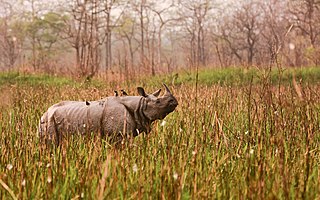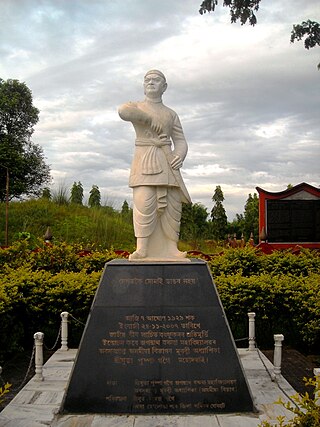
Assam is a state in northeastern India, south of the eastern Himalayas along the Brahmaputra and Barak River valleys. Assam covers an area of 78,438 km2 (30,285 sq mi). The state is bordered by Bhutan and Arunachal Pradesh to the north; Nagaland and Manipur to the east; Meghalaya, Tripura, Mizoram and Bangladesh to the south; and West Bengal to the west via the Siliguri Corridor, a 22 kilometres (14 mi) wide strip of land that connects the state to the rest of India. Assamese and Boro are the official languages of Assam, while Bengali is an additional official language in the Barak Valley.

Lachit Barphukan was an Ahom commander, known for his leadership in the Battle of Saraighat that thwarted an invasion by Mughal forces under the command of Ramsingh I.

The Assam Movement (1979–1985) was a popular uprising in Assam, India, that demanded the Government of India to detect, disenfranchise and deport illegal aliens. Led by All Assam Students Union (AASU) and All Assam Gana Sangram Parishad (AAGSP) the movement defined a six-year period of sustained civil disobedience campaigns, political instability and widespread ethnic violence. The movement ended in 1985 with the Assam Accord.

Barua is a common Assamese surname.

Ahom–Mughal conflicts refer to the period between the first Mughal attack on the Ahom kingdom in Battle of Samdhara in 1616 till the final Battle of Itakhuli in 1682. The intervening period saw the fluctuating fortunes of both powers and the end of the rule of Koch Hajo. It ended with the Ahom influence extended to the Manas river which remained the western boundary of the kingdom till the advent of the British in 1826.

The Assamese people are a socio-ethnic linguistic identity that has been described at various times as nationalistic or micro-nationalistic. This group is often associated with the Assamese language, the easternmost Indo-Aryan language, and most Assamese people live in the Indian state of Assam, especially in the Brahmaputra valley. The use of the term precedes the name of the language or the people. It has also been used retrospectively to the people of Assam before the term "Assamese" came into use. They are an ethnically diverse group formed after centuries of assimilation of Austroasiatic, Tibeto-Burman, Indo-Aryan and Tai populations, and constitute a tribal-caste continuum—though not all Assamese people are Hindus and ethnic Assamese Muslims numbering around 42 lakh constitute a significant part of this identity The total population of Assamese speakers in Assam is nearly 15.09 million which makes up 48.38% of the population of state according to the Language census of 2011.

Colonial Assam (1826–1947) refers to the period of History of Assam between the signing of the Treaty of Yandabo and Independence of India when Assam was under the British colonial rule. The political institutions and social relations that were established or severed during this period continue to have a direct effect on contemporary events. The legislature and political alignments that evolved by the end of the British rule continued in the post Independence period. The immigration of farmers from East Bengal and tea plantation workers from Central India continue to affect contemporary politics, most notably that which led to the Assam Movement and its aftermath.

Bengali Hindus are an ethnoreligious population who make up the majority in the Indian states of West Bengal, Tripura, Andaman and Nicobar Islands, Jharkhand, and Assam's Barak Valley region. In Bangladesh, they form the largest minority. They are adherents of Hinduism and are native to the Bengal region in the eastern part of the Indian subcontinent. Comprising about one-thirds of the global Bengali population, they are the second-largest ethnic group among Hindus after Hindustani Hindus. Bengali Hindus speak Bengali, which belongs to the Indo-Aryan language family and adhere to Shaktism or Vaishnavism of their native religion Hinduism with some regional deities. There are significant numbers of Bengali-speaking Hindus in different Indian states.
The Bengali Hindu diaspora is the worldwide population of the Bengali Hindus of Indian and Bangladeshi origin.
Bongal Kheda was a xenophobic movement in India, which aimed at purging out non-native job competitors by the job-seeking Assamese. Soon after the Independence of India, the Assamese Hindu middle class gained political control in Assam and tried to gain social and economic parity with their competitors, the Bengali Hindu middle class. A significant period of property damage, ethnic policing and even instances of street violence occurred in the region. The exact timeline is disputed, though many authors agree the 1960s saw a height of disruption. It was part of a broader discontent within Assam that would foreshadow the Assamese Language Movement and the anti-Bengali Assam Movement.
Dkhar, is a term used by the Khasis to refer to non-Khasi people in Meghalaya. It is non derogatory but some perceived it as derogatory. For Khasis any non-tribal is a dkhar and they address them by that term. In real, the term is mostly used against affluent Bengali Hindu settlers from West Bengal or the Bengali Hindu refugees from erstwhile East Pakistan It is sometimes abbreviated to ′Khar and may also denote a Khasi clan with the same name.

Islam is the second-largest and is the fastest-growing religion in Assam as per as decadal Census reports. The Muslim population was approximately 10.7 million, constituting over 34.3% of the total population of the state as of the late 2011 census, though some projections have estimated it as up to 14 million in 2021, giving Assam the second-largest Muslim population percentage in the country after Kashmir Reaching the region in the 13th century, Islam is the fastest-growing religion in Assam. Muslims are a majority in almost eleven districts of Assam and highly concentrated in four districts.
The Khoirabari massacre was an ethnic massacre of an estimated 100 to 500 immigrant Bengalis in the Khoirabari area of Assam, India, on 7 February 1983. Activists of the Assam Agitation sought to block an assembly election that day and had cut communications to the Bengali enclaves, which were perceived to be pro-election. Indigenous Assamese groups, who had held resentments toward the immigrant Bengalis, took advantage of the resulting isolation and surrounded and attacked the Bengali villages at night.
North Kamrup violence was a series of violent activities in North Kamrup, Assam, on 4–5 January 1980 between those who supported the Assam Movement and those who opposed it. Triggered by the death of a high school student, a member of the AASU, it led to a series of attacks and counter-attacks between Assamese and immigrant villages leading to a curfew. According to the Citizenship Rights Preservation Committee, representing Bengali speaking people, the violence was directed against linguistic, religio-linguistic, ethnic minorities and members of the CPI, CPI(M) and CPI(ML) political parties who opposed the Assam Movement. Many of the victims were Miya and it is alleged that the Army committed atrocities on Assamese villagers during the curfew. This was the first reported large-scale group clash during the Assam Movement.
The Goreswar massacre was the massacre of Bengali Hindus in Goreswar, in the Kamrup district of the Indian state of Assam. The massacre was part of a pre-planned pogrom, organized in a meeting of the local Teachers' Association.

The Miya people (মিঞা), also known as Na-Asamiya, refers to the descendants of migrant Muslims from the modern Mymensingh, Rangpur and Rajshahi Divisions, who settled in the Brahmaputra Valley during the British colonisation of Assam in the 20th-century. Their immigration was encouraged by the Colonial British Government from Bengal Province during 1757 to 1942 and the movement continued till 1947.
In May 1948, widespread rioting broke out in Guwahati and adjoining areas where Bengali Hindu businesses, schools and residences in general and Bengali Hindu staff of the Bengal and Assam Railway in particular were attacked. The Assamese nationalists who saw the Bengali Hindus as foreign usurpers in the territory of Assam led the attacks while Muslim League members joined them. The Bengali Hindus were looted and Bengali Hindu properties were looted and set on fire. No Bengali-speaking Muslim was attacked, as they were seen as Na Asamiyas who had adopted Assamese language and culture and therefore assimilated in the land Assam. The Guwahati riots mark the beginning of the Bongal Kheda movement.

Ahomisation was an assimilation process in the former Ahom kingdom of Assam by which the people from different ethnic groups in the region became a part of what is now considered as the Ahom population.

Bengali Hindus are the second largest Hindu community in Assam just after Assamese speaking Hindus. As per as estimation, around 6–7.5 million Bengali Hindus live in Assam as of 2011, majority of whom live in Barak Valley and a significant population resides in Assam's mainland Brahmaputra valley. Most Bengalis in Assamese dominated Brahmaputra valley are immigrants from neighbouring Bengal region and Tripura, while Bengalis in Barak Valley region of Assam are mostly native.
Anti-Bengali sentiment in India comprises negative attitudes and views on Bengalis in India. Though Bengalis have lived in different parts of India for centuries, they are subject to widespread discrimination, specially by the people from the North and North-east India. This can be either by any other community or in any particular place, due to reasons like inhabitation, discriminating sentiments, political reasons, Government actions, anti-Bangladeshi sentiment etc. The discriminative condition of Bengalis can be traced from Khoirabari massacre, Nellie massacre, Silapathar massacre, North Kamrup massacre, Goreswar massacre, Bongal Kheda etc. This has led to emergence of Bengali sub-nationalism in India as a form of protest and formation of many pro-Bengali organisations in India.










